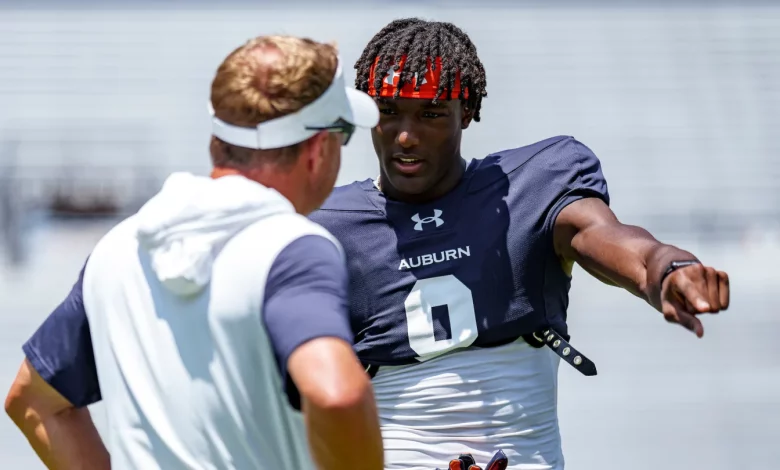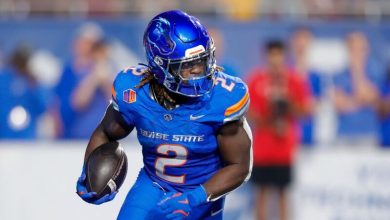CBS has named Auburn Tigers’ star wide receiver, Cam Coleman, a dark horse Heisman candidate, highlighting his potential this season.

In a college football landscape often dominated by quarterbacks and running backs, wide receivers have historically struggled to gain significant recognition in the race for the prestigious Heisman Trophy. However, this year, CBS Sports has named Auburn Tigers’ star wide receiver, Cam Coleman, as a dark horse candidate for the 2025 Heisman Trophy, a testament to his immense talent and the growing role that wide receivers are playing in modern college football. This recognition not only speaks to Coleman’s potential but also reflects the evolution of the game, where dynamic wide receivers are increasingly seen as key players capable of leading their teams to greatness.
The Heisman Trophy and Its Traditional Bias
The Heisman Trophy, awarded annually to the best player in college football, has long been viewed as a quarterback’s award. Historically, the trophy has been dominated by quarterbacks and running backs, with only a few wide receivers earning the honor. Notable wide receivers who have been in the Heisman conversation include Desmond Howard (Michigan, 1991), Tim Brown (Notre Dame, 1987), and more recently, Devonta Smith (Alabama, 2020). However, the position has often been overshadowed by the more glamorous, high-statistic positions such as the quarterback and running back.
In recent years, though, there has been a growing trend in college football where the wide receiver position has become more dynamic and central to a team’s offensive scheme. With the rise of high-powered passing offenses, including the air raid and spread systems, wide receivers are now being given more opportunities to shine. This shift in offensive philosophy has helped raise the profile of wide receivers and made them more viable candidates for awards like the Heisman Trophy.
Cam Coleman: A Rising Star at Auburn
Cam Coleman, a 6’3″ wide receiver from Phenix City, Alabama, is a product of this new era in college football. A five-star recruit and the No. 5 overall prospect in the 2024 recruiting class, Coleman has drawn attention for his unique combination of size, speed, and playmaking ability. As one of the top recruits in the country, Coleman had a list of suitors from the nation’s top programs, but ultimately, he chose to commit to Auburn, a decision that has already paid dividends for both him and the Tigers.
Auburn’s wide receiver corps has been a bit of a mystery in recent years. While the Tigers have seen flashes of brilliance from players, they have struggled to find consistency in the passing game. The addition of a player like Coleman has the potential to change the trajectory of the program, as he brings not only elite talent but also the ability to elevate the play of those around him. Coleman’s size and athleticism make him a matchup nightmare for defenders, and his ability to track the ball and make catches in difficult situations has already earned him a reputation as one of the most gifted receivers in college football.
The Offensive Revolution at Auburn
Auburn has long been known for its ground-and-pound style of football, with a heavy emphasis on the running game. However, the program has undergone significant changes in recent years, particularly in its offensive philosophy. In 2024, Auburn hired Philip Montgomery as the new offensive coordinator, a coach known for his ability to develop explosive passing attacks. Montgomery’s influence on the offense has been felt immediately, with the Tigers emphasizing a more balanced and dynamic approach to their offensive scheme.
This change in offensive direction could not have come at a better time for a player like Cam Coleman. With Montgomery’s guidance, Auburn’s offense is expected to become more pass-oriented, providing Coleman with the perfect platform to showcase his skills. The integration of a talented wide receiver like Coleman into this evolving offensive system could lead to a breakout season for both the player and the team. If the Tigers are able to harness their newfound passing game effectively, Coleman could emerge as one of the top wide receivers in the country—and perhaps even a legitimate Heisman contender.
Coleman’s Physical Traits and Playmaking Ability
One of the most compelling reasons for Coleman’s inclusion in the Heisman conversation is his combination of physical traits and playmaking ability. Standing at 6’3″ and weighing 205 pounds, Coleman has the size to overpower defenders and the speed to outrun them. His physicality allows him to go up and make contested catches in tight windows, while his quickness and agility make him a threat to break free from defenders in open space. Coleman’s versatility is also one of his greatest strengths, as he can be used in a variety of roles within the offense, including deep routes, short slants, and even reverses or jet sweeps.
His ability to stretch the field vertically, combined with his precise route-running and strong hands, gives quarterbacks a reliable target on every play. Whether it’s a quick slant over the middle, a fade route down the sideline, or a deep post, Coleman has the capability to excel in all aspects of the passing game. His ability to read defenses and make adjustments on the fly adds an extra layer to his game, allowing him to be productive regardless of how opposing defenses attempt to cover him.
Moreover, Coleman’s work ethic and dedication to his craft have earned him the respect of his coaches and teammates. Despite being a freshman, Coleman has quickly demonstrated a high level of maturity and football intelligence. His understanding of the game, combined with his physical abilities, has allowed him to adapt quickly to the college level and become one of the most promising players on Auburn’s roster.
A New Era for Auburn Football
The mention of Cam Coleman as a dark horse Heisman candidate represents a larger shift in Auburn’s football program. The Tigers are entering a new era under head coach Hugh Freeze, who has already made waves with his recruiting prowess and his ability to adapt his offensive system. Freeze’s offensive philosophy aligns well with the modern trends in college football, where fast-paced, high-scoring offenses are becoming the norm.
With Montgomery calling the plays and Coleman serving as the centerpiece of the passing attack, Auburn is poised for a resurgence. The Tigers have the talent to compete in the competitive SEC, and if Coleman can live up to his potential, Auburn could be in for a memorable season. As the team’s primary receiving weapon, Coleman could have a huge impact on Auburn’s success. If the Tigers win games and make a run in the SEC West, Coleman’s Heisman candidacy will continue to gain steam.
The Challenges Ahead for Coleman
Despite the optimism surrounding Coleman’s potential, there are still several challenges that could affect his Heisman campaign. The SEC is one of the most competitive conferences in college football, and Auburn will face stiff competition from programs like Alabama, Georgia, and LSU. These teams have traditionally been powerhouses, and their defenses will not be easy to overcome. Moreover, Coleman’s success will be largely dependent on Auburn’s quarterback play. While the Tigers have some promising quarterbacks, the team’s ability to establish a consistent passing attack will be crucial to Coleman’s individual success.
Additionally, the wide receiver position has historically had to fight an uphill battle in the Heisman race. With quarterbacks and running backs often receiving more media attention and opportunities to shine, Coleman will need to put up monster numbers throughout the season to stay in the Heisman conversation. This means that in addition to making spectacular plays, he will need to deliver in the most crucial moments of games, especially in high-profile matchups against ranked teams.
The Growing Trend of Wide Receivers in the Heisman Race
As college football evolves, so too does the Heisman Trophy conversation. In recent years, the award has begun to shift toward recognizing wide receivers who can make an impact in dynamic offenses. The success of players like Devonta Smith and Jamar Chase has shown that wide receivers can dominate games and earn recognition alongside quarterbacks and running backs. While wide receivers still face an uphill battle in the Heisman race, the increasing emphasis on passing attacks in college football has made it more likely that a player like Coleman could emerge as a serious contender.
Coleman’s inclusion in the Heisman conversation is a reflection of this growing trend, and it may open the door for other wide receivers to gain the same recognition in the future. With the right combination of talent, production, and team success, wide receivers are increasingly seen as valuable assets capable of shaping the outcome of major games. Coleman has all the tools to be the next player to capitalize on this shift and cement himself as one of college football’s brightest stars.









